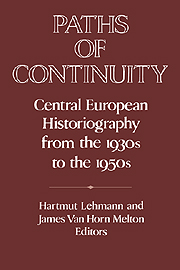Book contents
- Frontmatter
- Introduction: Continuities in German Historical Scholarship, 1933-1960
- 1 German Historiography from the 1930s to the 1950s
- 2 Friedrich Meinecke (1862-1954)
- 3 Change and Continuity in German Historiography from 1933 into the Early 1950s: Gerhard Ritter (1888-1967)
- 4 Hans Rothfels (1891-1976)
- 5 Franz Schnabel (1887-1966)
- 6 Heinrich Ritter von Srbik (1878-1951)
- 7 “Historical Social Science” and Political Myth: Hans Freyer (1887-1969) and the Genealogy of Social History in West Germany
- 8 Some Observations on the Work of Hermann Aubin (1885-1969)
- 9 From Folk History to Structural History: Otto Brunner (1898-1982) and the Radical-Conservative Roots of German Social History
- 10 Werner Conze (1910-1986): The Measure of History and the Historian's Measures
- 11 Continuity, Innovation, and Self-Reflection in Late Historicism: Theodor Schieder (1908-1984)
- Index
11 - Continuity, Innovation, and Self-Reflection in Late Historicism: Theodor Schieder (1908-1984)
Published online by Cambridge University Press: 05 January 2013
- Frontmatter
- Introduction: Continuities in German Historical Scholarship, 1933-1960
- 1 German Historiography from the 1930s to the 1950s
- 2 Friedrich Meinecke (1862-1954)
- 3 Change and Continuity in German Historiography from 1933 into the Early 1950s: Gerhard Ritter (1888-1967)
- 4 Hans Rothfels (1891-1976)
- 5 Franz Schnabel (1887-1966)
- 6 Heinrich Ritter von Srbik (1878-1951)
- 7 “Historical Social Science” and Political Myth: Hans Freyer (1887-1969) and the Genealogy of Social History in West Germany
- 8 Some Observations on the Work of Hermann Aubin (1885-1969)
- 9 From Folk History to Structural History: Otto Brunner (1898-1982) and the Radical-Conservative Roots of German Social History
- 10 Werner Conze (1910-1986): The Measure of History and the Historian's Measures
- 11 Continuity, Innovation, and Self-Reflection in Late Historicism: Theodor Schieder (1908-1984)
- Index
Summary
west german historical scholarship: problems concerning its historical self-understanding
West German Historical Scholarship: Problems Concerning its Historical Self-understanding / From the very beginning, West German historical scholarship has had problems understanding itself. This was evident immediately after 1945. Of course, historians already had been forced to bring their traditional understanding of their discipline into line with new political demands during the period of National Socialist rule. But the end of the Second World War, which they experienced as a catastrophe, confronted them for the first time with fundamental questions concerning the possibility and limits of a historical orientation in the present and the role of their discipline in the practical life of their age. As is well known, they responded to this challenge by restoring the historicist scientific tradition, and when the scholarly community underwent a generational change in the culturally restive years of the late 1960s and early 1970s, they were again faced with the difficulties of legitimating its disciplinary status and demonstrating its relevance. In one energetic burst of innovation, they modernized their discipline by borrowing modes of thought from structural and social history. At the same time, they distanced themselves decisively from historicism, which had survived the Third Reich along with them and on the basis of which West German historical scholarship had indisputably established itself as a discipline during the postwar period.
- Type
- Chapter
- Information
- Paths of ContinuityCentral European Historiography from the 1930s to the 1950s, pp. 353 - 396Publisher: Cambridge University PressPrint publication year: 1994



